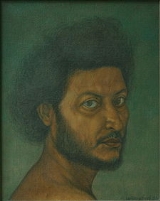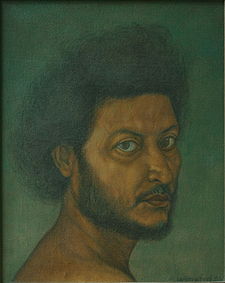
Anil Karanjai
Encyclopedia

East Bengal
East Bengal was the name used during two periods in the 20th century for a territory that roughly corresponded to the modern state of Bangladesh. Both instances involved a violent partition of Bengal....
, he was educated in Benaras, where his family settled subsequent to the Partition of the Indian subcontinent in 1947. As a small child he had spent long hours playing with clay to make toys and arrows. He also began very early to draw animals and plants, or whatever inspired him. In 1956 he dropped out of school to become a full time student at Bharatiya Kala Kendra, headed by Karnaman Singh, a master of the Bengal School and a Nepali by origin. This teacher encouraged Anil to experiment widely and to study the art of every culture. Anil remained here until 1960, exhibiting regularly and teaching other students. During the same period, he practised miniature painting at Bharat Kala Bhavan (Benaras Hindu University) under the eye of the last court painter to the Maharaja of Benaras. He also enrolled at Benaras Polytechnic to learn clay modelling and metal casting.
The Revolutionary 1960s
Throughout the revolutionary 1960s, Anil was at the forefront of the Indian and international politico-cultural movement. In 1962, with Karunanidhan Mukhopadhyay, he co-founded United Artists. Their studio, named ‘Devil’s Workshop’, attracted artists, writers, poets and musicians from across India and abroad. The group established the first art gallery of Benaras in a rundown teashop, Paradise Cafe, frequented by some of this vibrant city’s most colourful characters. Anil and others of the group also at this time lived in a commune and exchanged ideas and experiences with ‘seekers’ from many countries.Anil Karanjai was a very active member of the renowned Bengali radical group, Hungry Generation
Hungry generation
The Hungry Generation was a literary movement in the Bengali language launched by what is known today as the Hungryalist quartet i.e. Shakti Chattopadhyay, Malay Roy Choudhury, Samir Roychoudhury and Debi Roy alias Haradhon Dhara, during the 1960s in Kolkata, India...
, otherwise known as the Hungryalism হাংরি আন্দোলন movement, composed in the main of writers and poets; Anil and Karunanidhan were the chief Hungryalism artists. Anil was associated with the Beat Generation
Beat generation
The Beat Generation refers to a group of American post-WWII writers who came to prominence in the 1950s, as well as the cultural phenomena that they both documented and inspired...
when Allen Ginsberg
Allen Ginsberg
Irwin Allen Ginsberg was an American poet and one of the leading figures of the Beat Generation in the 1950s. He vigorously opposed militarism, materialism and sexual repression...
and Peter Orlovsky
Peter Orlovsky
Peter Anton Orlovsky was an American poet.-Life and work:Orlovsky was born in the Lower East Side of New York City, the son of Katherine and Oleg Orlovsky, a Russian immigrant. He was raised in poverty and was forced to drop out of Newtown High School in his senior year so he could support his...
interacted with the Hungryalists during their sojourn in India. The Hungryalists were based in Patna, Calcutta and Benaras and they also forged important contacts with the avant garde in Nepal. Anil created numerous drawings for Hungryalist publications. He also contributed posters and poems. And he was a founder of the little magazine movement in India. In 1969, he moved to New Delhi where he organised and participated in a ‘Little Magazine Exhibition’ at Delhi Shilpi Chakra.
Anil Karanjai's Art and World View
In the early 70s Anil Karanjai made a huge impact in Indian art circles with his technical maturity and his dreamlike, often nightmarish, angry imagery. In many of his early paintings, contorted human forms emerge from weird landscapes to threaten and accuse; natural forms - rocks, clouds, animals and trees - become a vehicle for mass consciousness, waiting to release its energy against centuries of oppression. After his move to Delhi, his grotesque human forms were often integrated with ruins, a metaphor for the tyranny of history. An element of satirical humour is not, however, absent from most of these canvases. Moreover, Anil’s imagery sometimes communicates a poetic romanticism, almost soft in expression. This would become much more pronounced in many of his later works in which landscape would become the predominant motif and in which the human presence is subtly suggested, often by a pathway or steps leading to a mysterious destination. Ghostly whispers also echo in his landscapes through old walls, gateways or sculpted pillars.In 1972 he won a National Award, but this was to have little impact on his life. He was the quintessentially anti-establishment artist and he would remain so for the rest of his life. The intense collective spirit and accomplishments of the 1960s had made a huge mark on Anil. Thereafter he often felt creatively isolated. As a politico-cultural activist he would always remain committed, and he would maintain a relationship with the leading (হাংরি আন্দোলন) Hungry generation
Hungry generation
The Hungry Generation was a literary movement in the Bengali language launched by what is known today as the Hungryalist quartet i.e. Shakti Chattopadhyay, Malay Roy Choudhury, Samir Roychoudhury and Debi Roy alias Haradhon Dhara, during the 1960s in Kolkata, India...
writers, Malay Roy Choudhury
Malay Roy Choudhury
Malay Roy Choudhury is a Bengali poet and novelist who founded the "Hungryalist Movement" in the 1960s. His literary works have been reviewed by sixty critics in HAOWA 49, a quarterly magazine which devoted its January 2001 special issue to Roy Choudhury's life and works...
, Subimal Basak
Subimal Basak
Subimal Basak, is an Indian fiction writer. He is a member of the Hungry generation, with Samir Roychoudhury, Falguni Roy, Shakti Chattopadhyay and the movement's creator Malay Roy Choudhury....
, Samir Roychoudhury
Samir Roychoudhury
Samir Roychowdhury , one of the founding fathers of the Hungry Generation 1961-1965 ,was born at Panihati, West Bengal, India in a family of artists, sculptors, photographers and musicians...
, Tridib Mitra and others of that era. But as an artist he found himself increasingly at odds with his contemporaries. As time progressed, he tended more and more towards modes of expression considered unfashionable by the art establishment and by the new rich art collectors that emerged as India became a global economy. This is particularly true of his final decade when pure landscape became his principle vehicle of communication. Yet even in his lonely landscapes people are never far away. Indeed, his trees and other natural elements are animated by strangely human gestures. Sometimes the whole of nature seems to be conspiring against a hidden enemy, reflecting Anil’s deep concerns as an environmental activist.
But it was not merely his subject matter that earned him neglect and even opprobrium among the powerful groups that decide upon the worldly success or failure of artists. At play too was the realism that characterises his late works. On the surface these may appear almost classical, yet for those many who appreciate them, they are expressions of a heightened realism that resonates throughout our contemporary age. Anil himself equated his work with a ‘magical realism’. As he said in a film on him, The Nature of Art: “My paintings are a dream, a dream of nature.” The emotional content of the paintings was of supreme importance. In this, Anil drew from his immense knowledge of Indian classical music, particularly with regard to the raga, whereby a composition conveys the mood or feeling of a particular season or time. In art, its equivalent is called rasa, literally sap or essence, an aesthetic approach that Anil understood to be timeless and universal and which he sought to interpret in his paintings.
In his mature phase, Anil’s philosophy of art had undergone a major metamorphosis. Whereas his early work could be described ideologically as confrontational, his late work was conceived and executed to give solace to the spectator. He came to see himself as a skilled professional, akin to a doctor. As he asserted on many occasions, including in the same film: “The role of today’s artist is to heal the wounds inflicted by our society.”
Throughout his career, Anil had worked in a variety of media, particularly in oils which he revered highly. But in the final years he completed many fine works in pastel crayons, above all dry pastel. This is a medium in which he showed greater mastery and inventiveness than probably any other Indian artist of his time. In his final decades, Anil also became a prolific portraitist. He carried out a number of commissioned portraits as a means of survival, but most of his best works in this genre are those of people close to him. Following the tradition of masters of the past, he produced a number of self-portraits. A few of these are among his most intensely expressive works.
See also
- Malay Roy ChoudhuryMalay Roy ChoudhuryMalay Roy Choudhury is a Bengali poet and novelist who founded the "Hungryalist Movement" in the 1960s. His literary works have been reviewed by sixty critics in HAOWA 49, a quarterly magazine which devoted its January 2001 special issue to Roy Choudhury's life and works...
- Samir RoychoudhurySamir RoychoudhurySamir Roychowdhury , one of the founding fathers of the Hungry Generation 1961-1965 ,was born at Panihati, West Bengal, India in a family of artists, sculptors, photographers and musicians...
- Subimal BasakSubimal BasakSubimal Basak, is an Indian fiction writer. He is a member of the Hungry generation, with Samir Roychoudhury, Falguni Roy, Shakti Chattopadhyay and the movement's creator Malay Roy Choudhury....
- Tridib MitraTridib MitraTridib Mitra was one of the pioneers of the Hungry generation movement in Bengali literature which changed the literary landscape of West Bengal once for all. With his wife Alo Mitra he edited Hungry generation magazines The Waste Paper in English and Unmarga in Bengali...
- Basudeb DasguptaBasudeb DasguptaBasudeb Dasgupta , a Bengali novelist and short-story writer , is considered as one of the most significant avant-gardes and controversial figures in the history of Bengali literature.-Writings:Basudeb's major contribution to Bengali literature spanned from the early 1960s to mid 80's...
- Allen GinsbergAllen GinsbergIrwin Allen Ginsberg was an American poet and one of the leading figures of the Beat Generation in the 1950s. He vigorously opposed militarism, materialism and sexual repression...
- Hungry generationHungry generationThe Hungry Generation was a literary movement in the Bengali language launched by what is known today as the Hungryalist quartet i.e. Shakti Chattopadhyay, Malay Roy Choudhury, Samir Roychoudhury and Debi Roy alias Haradhon Dhara, during the 1960s in Kolkata, India...
- Shakti ChattopadhyayShakti ChattopadhyayShakti Chattopadhay was a Bengali poet and writer, widely regarded as one of the greatest poet of 20th century Bengali literature. -External links:...

